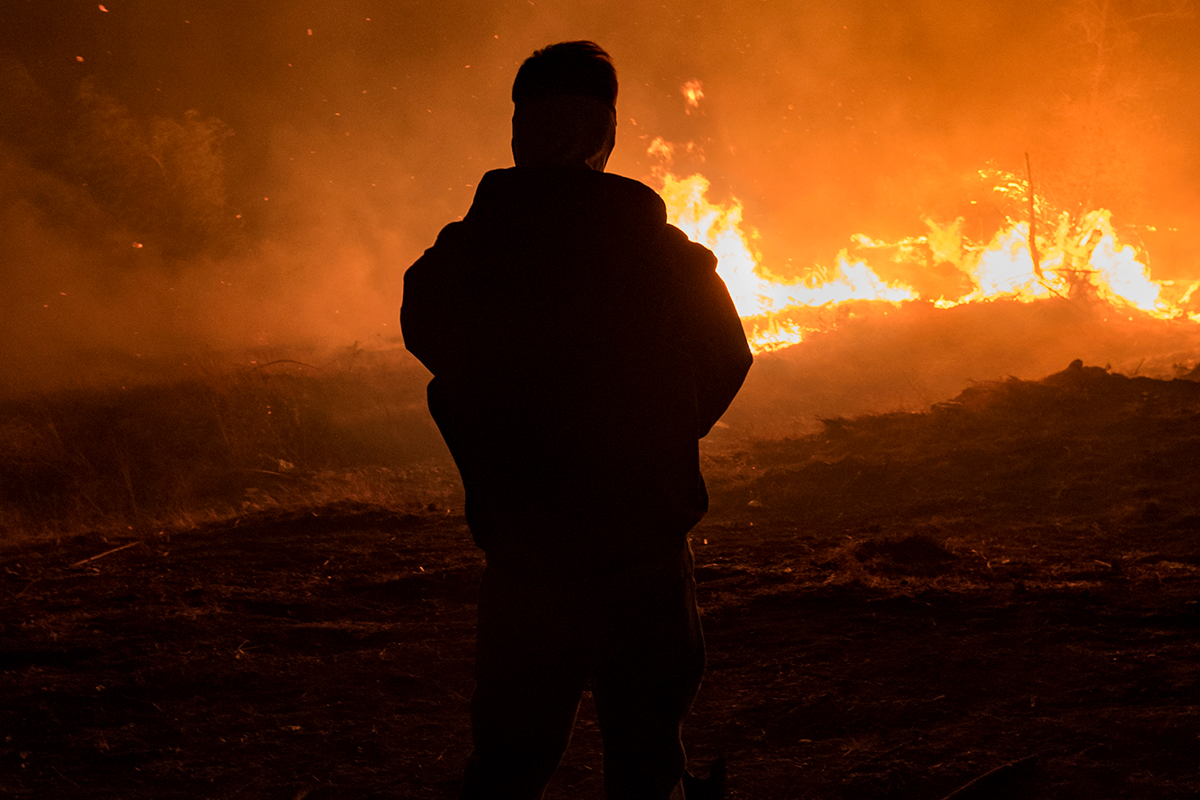Did The Wildfire Rabbit 'Rescuer' Doom A Litter of Babies?

A video making the rounds online shows a rabbit dashing through a gap in the flames of the huge Thomas fire in California. A man rushes after the animal and stops at the edge of the fire line, anxiously dancing around and trying to coax the critter out of the burning brush. A few moments later, the rabbit bounds back through the same flame gap, and the guy scoops it up, cradling it pinned against his chest.
The dramatic footage has, understandably, gone viral, with some folks online calling the man's actions heroic and some calling them stupid. Most people seem to uncritically accept, however, that this man, in risking his life, saved the rabbit.
But an animal flitting around at the edge of a fire might not need saving at all. In fact, it might have a very good reason for being there. [Furry Bundles: The World's 5 Smallest Mammals]
Most small mammals are good at dealing with fire
In general, wild animals are good at dealing with wildfires, scary events that are still more or less regular features of many ecosystems, according to ecologists. When a wildfire moves through an area, according to a January 2000 report from the U.S. Forest Service, the blaze usually fails to kill very many animals outright.
Burrow-dwelling small mammals, like the desert cottontail rabbits common to Southern California, will sometimes ride out surface fires underground. As long as the animals' holes remain well-ventilated, most burrow-dwellers make it through the majority of fires just fine, that report said.
Critters that spend their lives above ground, like the jackrabbits also common to the region, generally flee the flames.
While a few individual animals might die in any given fire, populations of most species are well-equipped to make it through with only small losses, the Forest Service said. And afterward, many small-mammal populations boom in fire-stricken areas, as more food and nesting grounds become available, the Forest Service wrote.
Get the world’s most fascinating discoveries delivered straight to your inbox.
But this rabbit was in immediate danger!
Well … maybe.
But a rabbit that's not running away from a fire might have a very good reason for sticking around, experts say. Or several good reasons.
The available research into the behavior of animals during wildfires is limited, because most biologists aren't following firefighters up to the edge of dangerous flames. But the research does exist.
E.V. Komarek documented decades of observations of animals dealing with fire, published in a paper titled "Fire and Animal Behavior" in the journal Proceedings: 9th Tall Timbers Ecology Conference 1969.
For 25 years, Komarek attended an annual rabbit hunt on the Tall Timbers Plantation in Florida, where the plantation owner would set fire to a portion of the land to flush out marsh rabbits and eastern cottontails. The latter is part of the same genus as the desert cottontail, which is abundant in Southern California.
While marsh rabbits caught in the hunt sometimes emerged singed or burned from the fire, Komarek wrote, he "never examined a cottontail that was burned, scorched or killed by fire. … Apparently, the behavior patterns of the cottontail under these conditions made it much less prone to injury from fire than the marsh rabbit."
Some people might assume that animals are as scared or as endangered by fire as people are, but there's no good reason to think that's the case, Komarek cautioned. In fact, Komarek said, some critters have very good reason to run into a fire: to save their young.
In July 1969, Komarek was stationed at the edge of a controlled burn when a cotton rat ran by. After pausing to observe Komarek, the little rodent ran across a firebreak, "squeaking continuously and excitedly," right up to the edge of the flames.
"While I watched," Komarek wrote, "the cotton rat 'herded' a young juvenile into the runway from the surrounding grass. … The adult chased it a short distance away from the flames and returned to repeat the same process with two other young."
Komarek said he saw other cotton-rat parents perform similar rescues, sometimes hauling their infants away by the scruffs of their necks.
"Frequently, we have seen cotton rats run across the line of fire," Komarek wrote, "apparently finding a weak spot in it, and return to the smoking burn without injury. However, under certain circumstances, in certain types of cover, they are occasionally singed or killed."
Does that mean that a California rabbit, whose species is unknown, seen running through gaps in wildfire flames is on a rescue mission itself? Not necessarily. There don't seem to be any direct reports of rabbits performing the exact sort of rescue operation Komarek observed in rats Researchers, working from limited data, aren't sure exactly why cottontails are so good at surviving wildfires along with their young.
What is definitely true is that cottontails, like most animals in fire-prone areas, are pretty good at surviving wildfires. It's also true that certain rodents definitely perform rescue operations to go after their young. And it's true that, according to a fact sheet published by Texas Tech, desert cottontails give birth to litters as late as December.
Did the rabbit "rescuer" prevent an adult from saving its young? Not necessarily — we just don't have enough information. But if you see a wild animal moving around near a fire, the best thing you can do is leave the creature to its business. It knows what it's doing.
Originally published on Live Science.

 Live Science Plus
Live Science Plus





